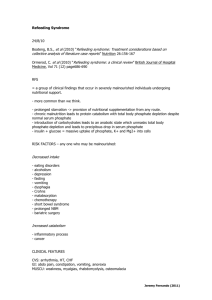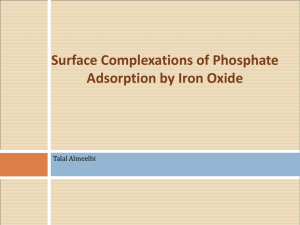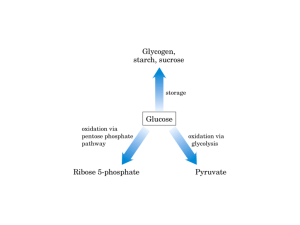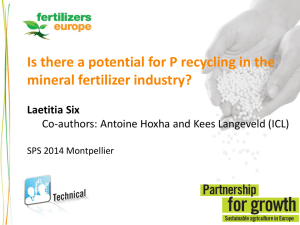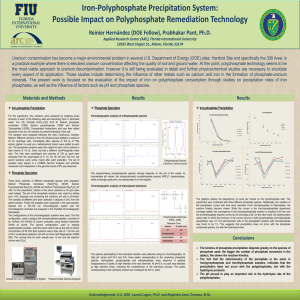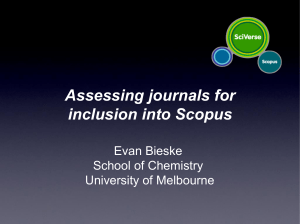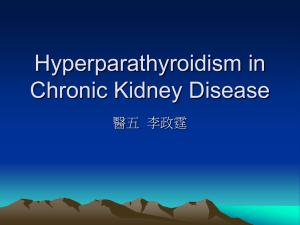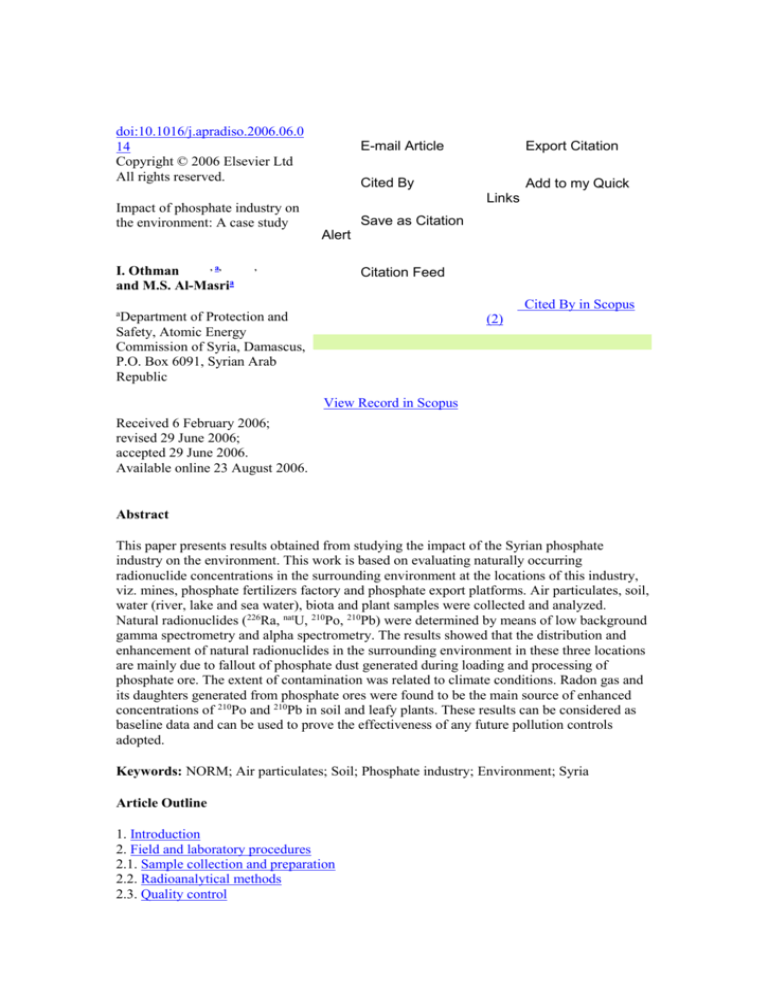
doi:10.1016/j.apradiso.2006.06.0
14
Copyright © 2006 Elsevier Ltd
All rights reserved.
E-mail Article
Export Citation
Cited By
Add to my Quick
Links
Impact of phosphate industry on
the environment: A case study
Save as Citation
Alert
, a,
I. Othman
and M.S. Al-Masria
,
Citation Feed
Cited By in Scopus
a
Department of Protection and
Safety, Atomic Energy
Commission of Syria, Damascus,
P.O. Box 6091, Syrian Arab
Republic
(2)
View Record in Scopus
Received 6 February 2006;
revised 29 June 2006;
accepted 29 June 2006.
Available online 23 August 2006.
Abstract
This paper presents results obtained from studying the impact of the Syrian phosphate
industry on the environment. This work is based on evaluating naturally occurring
radionuclide concentrations in the surrounding environment at the locations of this industry,
viz. mines, phosphate fertilizers factory and phosphate export platforms. Air particulates, soil,
water (river, lake and sea water), biota and plant samples were collected and analyzed.
Natural radionuclides (226Ra, natU, 210Po, 210Pb) were determined by means of low background
gamma spectrometry and alpha spectrometry. The results showed that the distribution and
enhancement of natural radionuclides in the surrounding environment in these three locations
are mainly due to fallout of phosphate dust generated during loading and processing of
phosphate ore. The extent of contamination was related to climate conditions. Radon gas and
its daughters generated from phosphate ores were found to be the main source of enhanced
concentrations of 210Po and 210Pb in soil and leafy plants. These results can be considered as
baseline data and can be used to prove the effectiveness of any future pollution controls
adopted.
Keywords: NORM; Air particulates; Soil; Phosphate industry; Environment; Syria
Article Outline
1. Introduction
2. Field and laboratory procedures
2.1. Sample collection and preparation
2.2. Radioanalytical methods
2.3. Quality control
3. Results and discussion
3.1. The impact of phosphate mining activities in the vicinity of phosphate mines and
workers’ villages
3.2. The impact of phosphoric acid production plant on the environment
3.3. The impact of phosphate loading activities on the vicinity of Tartous port
4. Conclusion
Acknowledgements
References
1. Introduction
Phosphate rocks contain relatively high concentrations of naturally occurring radioactive
materials from the uranium and thorium decay series (238U and 232Th). Mining, milling,
transporting of phosphate ores, manufacturing of phosphate fertilizers and using phosphate
fertilizers containing uranium are ways in which the workers, public and the environment are
exposed to enhanced natural radioactivity (UNSCEAR, 1993; IAEA, 2004). Most of these
natural radionuclides are found in the solid waste of the phosphate fertilizer industry such as
phosphogypsum, the discharged effluents such as radon gas and dust containing radioactivity.
Many studies in the world have been carried out to assess the risk to humans and to the
environment (Barisic et al., 1992; Carvalho, 1995; Hamam and Landsberger, 1994; Marovic
and Sencar, 1995; Martinez and Garcia, 1996; Martinez et al., 1994; Bolivar et al., 1994;
McCartney et al., 1992; McDonald et al., 1991; Rutherford et al., 1994; Timmrmanas and
Van der Steen, 1996). Some studies (UNSCEAR, 1993; Othman et al., 1992; Othman, 1993)
considered radon gas to be the most important hazard to workers and public in the mines area
and the phosphate factory including phosphogypsum piles; the radiation dose due to
inhalation of radon daughters can be relatively high. Air emissions (gaseous and particulates)
from phosphate rock processing plant in the Thessaloniki area of northern Greece have
resulted in collective dose commitment to lung tissue of 2×10−9 person Gy y−1 for 238U
(Papastefanau, 2001). On the other hand, phosphogypsum is also considered to be a health
hazard, and many studies (Rutherford et al., 1994; IAEA, 2004) showed that leaching of
radionuclides from phosphogypsum contaminates the surrounding environment and especially
the groundwater. Other studies (Barisic et al., 1992; Carvalho, 1995; Marovic and Sencar,
1995; Martinez et al., 1994; McCartney et al., 2000) showed that effluents discharges and
especially into sea may enhance radioactivity in sediment, water and marine biota. McDonald
et al., 1996 summarized most aspects of technologically enhanced radioactivity in the UK
marine environment. Their results indicated areas of natural decay series due to discharges
from the Whitehaven phosphate fertilizers plants. More recent study (Betti et al., 2004)
carried out for the European Commission (Marina II) was focused on discharges of
radionuclides from the Naturally Occurring Radioactive Materials (NORM) industries
including the phosphate industry into north European marine waters. The collective dose rate
due to such discharges was found to be 200 man Sv y−1. Another study (El-Mamoney and
Khater, 2004) was conducted on the impact of phosphate mining activities in the Safaga
Quusein region on the Red Sea; relatively high levels of 226Ra, 238U, 210Po and 210Pb were
reported.
In Syria, the main phosphate mines are situated near Palmyra Fig. 1. There are two open pit
mine regions that are separated by about 25 km; more than 2000 workers are employed in this
industry and live in two villages located near the mines (Othman et al., 1993). The climate is
very hot and dry where strong winds may a rise. Most of the mined phosphate ore (around 2.8
million tonnes per year) has been exported for more than 20 years in large quantities via one
of the main Syrian ports (Tartous) situated on the eastern part of the Mediterranean Sea
(34°54′N, 35°52′E). About 300,000 tonnes of phosphate ore are transferred from the mines by
train and processed at the phosphate fertilizer factory in Homs (180 km N of Damascus) since
the early 1980s. During the process called “wet process” Ca3(PO4)2 ore is reacted with H2SO4
to form phosphoric acid and phosphogypsum. Phosphogypsum composed mainly of CaSO4
and contains impurities such as Al, P, F, Si, Fe, Mg as well as many trace elements, including
the rare earth elements and naturally occurring radioactive materials (226Ra and 210Po). This
has led to the production of tonnes of phosphogypsum, which are currently placed in a large
plastic lined storage pit built nearby the factory in 1995; disposing of phosphogypsum outside
this pit is currently prohibited to avoid environmental pollution. Phosphogypsum is
transferred from the factory and pumped into the pit through pipes by mixing with water. The
water is pumped back to the factory for re-use after filtration.
Full-size image (18K)
Fig. 1. Syrian phosphate industry locations.
Studies on the impact of this industry on the environment were limited to the workplace near
the mines, where radon concentrations in air and gamma exposure and hence radiation dose to
workers have been determined (Othman et al., 1992). Uranium levels in urine, blood and hair
of mine workers were also determined (Othman, 1993); Uranium concentration in the Syrian
phosphate ore varies between 55 and 100 ppm (Abbas and Jubeli, 1996). Therefore, a strategy
to assess the impact of emissions and discharges of this industry on the surrounding
environment has been formulated. This strategy is based on evaluation of naturally occurring
radionuclides concentrations in the surrounding environment in three main elements of this
industry, viz. mines, phosphoric acid production plant and the phosphate export. The strategy
was implemented by conducting the following measurements:
(1) Enhancement of naturally occurring radionuclides in soil and air particulates in the mining
areas and the workers’ villages.
(2) Levels of naturally occurring radionuclides in the surrounding environment of the
phosphoric acid processing plant in Homs. This study includes air particulates, surface water,
agriculture crops and plants.
(3) The impact of phosphogypsum piles and storage pit on the surrounding environment.
(4) The impact of loading activities on the nearby marine environment of Tartous port on the
Mediterranean Sea.
(5) Enhancement of naturally occurring radionuclides in air particulates and soils in the
Tartous port area due to phosphate loading activities into ships.
The main objective of this paper is to summarize the results obtained through the
implementation of this strategy.
2. Field and laboratory procedures
2.1. Sample collection and preparation
Air particulates: Sampling of air particulates was carried out during March 1999 and May
1999 in the two mine areas (Knefees and Al-Sharkia) and during June 1998 and December
1998 at port Tartous. Sampling locations in the Tartous port and the Knefees mine area are
shown in Fig. 2 and Fig. 3, respectively. Sampling was carried out during the year 2002 from
the phosphate fertilizers site every 2 months (Fig. 4). Reference sites for the three areas were
chosen far from the operations. Air particulates were collected using high volume air
samplers (HVAS) (Grasby General Metal Works, USA) with EPM 2000 WHATMAN fibre
glass filters (20×25 cm) with airflow of 4.2–102 m3 h−1. Sampling was performed over 4 days
for each sampling campaign; two to three samplers were operated at each site simultaneously.
Total suspended particulates (TSP) concentrations were determined using the weighing
technique.
Full-size image (67K)
Fig. 2. Sampling locations at Knefees mines area.
Full-size image (43K)
Fig. 3. Air and soil sampling locations at Tartous port.
Full-size image (58K)
Fig. 4. Sampling locations around the Phosphate fertilizer area.
Soil samples: Soil samples were also collected from the same locations used for air particulate
sampling in addition to other sites where public and workers are expected to be present for
long periods of time. Only surface soil samples (0–5 cm) were collected (about 1 kg) from
each site; stones and plants were removed from the samples manually and the samples were
oven-dried at 90 °C for 24 h, ground, homogenised and sieved to pass through a 560 μm
sieve.
Plant samples: All plant samples were collected by hand from an area of 100 m× 100 m
(collective sample), placed in plastic bags and transported to the laboratory; sample volumes
varied from 50 to 3000 g depending on the availability of plants in each site. The samples
were taken from 20 agricultural areas around the phosphate fertilizer factory where wheat,
leafy vegetables, fruits, grass and some tree leaves were collected. Samples were then cleaned
manually (but not washed) to remove adhering particles and dried in the oven at 90 °C for
24 h. The samples were ground, homogenised and sieved to pass through a 560 μm sieve.
Water samples: Water (30 l) samples were collected from surface water (Orontes River and
Quttina Lake) near the phosphate fertilizer factory. The samples were acidified by adding
concentrated hydrochloric acid (5 ml/l of water); pH value was determined to be less than 2.
Marine samples: Three sampling programs were carried out; the first was executed on the 22
October 1997, while the second and the third were carried out on the 5 May 1998 and 26 June
1999 respectively. Sediments (1 kg), seawater (50 l), fish, algae and other biota samples were
collected from 14 sampling sites as shown in Fig. 2. Sediment samples were taken from the
surface layer at the bottom of each location by grab sampler or scuba divers. Water samples
were acidified by adding concentrated hydrochloric acid. Sediment, fish, algae and crab
samples were dried in the oven at 90 °C for 24–48 h.
2.2. Radioanalytical methods
Determination of 210Po and 210Pb: Each air filter was cut into small pieces and digested using
concentrated nitric acid for at least 24 h after addition of a known amount of 208Po (0.2 Bq) as
a yield tracer for determination of 210Po and 210Pb. The filtrate was then divided into two equal
portions; one for uranium determination and the other for 210Po and 210Pb determinations.
Concentrations of 210Po and 210Pb in soil (0.5 g), plant (10 g of dry materials) and the filtrates
were measured using the standard technique (the silver disc technique) (Harley, 1978). Alpha
counting of 208Po (5.15 MeV) and 210Po (5.30 MeV) was done using an alpha spectrometer
(Oasis, Oxford) with a passivated ion-implanted silicon detector (active area 300 mm2, 3.6
background counts per day, 100 μm minimum depletion depth and 30 keV
-energy
resolution at 5.30 MeV). The plating and counting were then repeated after 6 months of
storage of the solution to measure the ingrowth of new 210Po from 210Pb to calculate the 210Pb
concentration in the original sample. The lower limit of detection of the method used was
0.4 Bq kg−1 dry wt.
For water samples, 210Pb and 210Po were precipitated from 4 l by MnO2; the precipitate being
dissolved in 1.5 mol l−1 HCl and processed as described for solid samples.
Determination of radium isotopes: The samples were measured by gamma spectrometers
(Eurysis Systems) using high resolution (1.85 keV at 1.33 MeV), high relative efficiency
(80%), low background HpGe detectors. 226Ra, 224Ra and 228Ra were determined by measuring
their gamma emitter daughters, 214Pb (351.9 keV) and 214Bi (609 keV), 212Pb (238 keV) and
212
Bi (727.3 keV) and 228Ac (911.1 keV). Efficiency calibration was performed using
reference samples (RGU, RGTH and RGK) provided by the International Atomic Energy
Agency, IAEA. The lower limits of detection for the measured radionuclides derived from the
background measurements at 100,000 s are found to be 3 Bq kg−1 for 226Ra and 228Ac.
Determination of Uranium: Uranium concentrations in the filters were determined using the
flourometric technique. For soil samples analysis, 0.5 g of each soil sample (duplicate) was
digested using a combination of mineral acids (nitric and hydrochloric acid) for at least 24 h.
Uranium was then separated from the sample using an ion exchange column (Dowex 1×4)
and measured using Flourometry instrument (Jerrel-Ash 27000, Advanced Technical Services
Gmbh Swiss) (Othman and Yassine, 1995).
2.3. Quality control
Quality control procedures were applied using homemade control samples and reference
samples provided by IAEA and EML (Environmental Monitoring Laboratory, Department of
Energy, USA). In addition, all methods and laboratories used in this study are validated
according to Eurachem guide and ISO17025.
3. Results and discussion
3.1. The impact of phosphate mining activities in the vicinity of phosphate mines and
workers’ villages
Radon exposure levels in the phosphate mines were first measured in 1990 in order to assess
radiation risks to workers and their families living near the mines area (Othman et al., 1992).
However, Palmyra and the mining regions (in the middle of the Syrian Badia) are considered
to be in a dry area where dust is likely to occur at most times of the year, therefore, air
particulates are also considered to be a health hazard; dust carrying phosphate ore particulates
containing NORM being also a radiation health hazard. Total suspended particulates (TSP) in
phosphate mines air have been measured to determine radioactivity content in air particulates
and to evaluate the impact of mining activities on the vicinity of phosphate mines. Table 1
shows the mean values of TSP, uranium, 210Po and 210Pb concentration in air particulates
collected from the Knefees mine area and the workers’ village. The highest TSP
concentrations were 24,106 and 55,358 μg m−3 in Knefees mine and Al-Sharkia mine,
respectively; the highest concentrations observed in the Al-Sharkia mines area are due to the
fact that more milling and mining operations are carried out in this mine. However, all of the
reported values of TSP are much higher than the Maximum Permissible Concentrations
(120 μg m−3) (WHO, 1987). On the other hand, 210Po and 210Pb concentrations in air
particulates of all sites were found to be relatively higher than the natural levels (0.47–
3.7 mBqm−3, Eisenbud and Gesell, 1997); the highest 210Po and 210Pb concentration in
Knefees mine sites were 47 and 50 mBq m−3, respectively. These levels can reflect the
amount of phosphate ore elevated in air and also the radon gas concentration in air. In
addition, uranium concentration varied between 5 and 811 ng m−3 in Knefees mine sites,
while generally lower values were observed in Al-Sharkia mines area (not more than
207 ng m−3). Moreover, lower levels of radionuclides in the Al-Sharkia workers’ village were
observed. The Sharkia worker village was built after Knefees village and several
considerations concerning pollution controls measures to decrease the impact of the mining
activities on the worker village were taken (distance, wind direction and new equipment).
However, all reported values for uranium in both mining areas are much higher than the
natural levels, which is about 2.1 ng m−3 (Eisenbud and Gesell, 1997).
Table 1.
Mean values of uranium, 210Po and 210Pb concentration in air particulates at phosphate mines
(Knefees)
Site
no.
TSP+±1 SD
(μg m−3)
U±1 SD
(ng m−3)
210
Po±1 SD
(mBq m−3)
210
Site description
1
Administration
building
3466±2523
257±155
6.3±1.3
3.1±0.7
2
Maintenance
workshop
925±334
79±54
1.6±0.4
1.6±0.4
3
Workers’ village
877±371
5±0.8
1.8±0.3
1.1±0.6
4
Control room
22304±13399
670±294
47±25
50±29
5
The factory
24106±7458
811±308
42.9±13.9
34.8±11.2
6
Mine area
8317±4408
127±29
11.6±3.3
14.2±9.0
Pb±1 SD
(mBq m−3)
Full-size table
+
Two filters were collected and analyzed.
Dust containing radioactivity is precipitated in the surrounding areas either as wet or dry
deposition and the activity of surface soil can reflect this precipitation; fine particulates may
travel for longer distances and they are more hazardous. However, radioactivity content of
soil samples collected from the vicinity of the two mines areas were found to be distance and
wind direction dependant; the concentrations of the studied radionuclides decrease as the
distance from the mines area increases, Table 2. The effect of mining processes is very clear
near the mine area. Uranium content in soil samples collected near the Knefees village clinic
was found to be 35 mg kg−1, which is much higher than the natural levels reported in Syria
(2–5 mg kg−1) (Othman and Yassine, 1995). In addition, 210Po and 210Pb concentrations were
also high in those samples collected near the village school; 173 and 233 Bq kg−1 being
observed for 210Po and 210Pb, respectively. These high levels are due to relatively high radon
concentrations in the area and not to the transport of phosphate ore dust from the mines area
by wind to the village. Similar values were also found in Al-Sharkia worker village. This is in
agreement with the previous study (Othman et al., 1992) where radon gas was found to be
high in the village houses. The equivalent effective dose of 0.98 m Sv y−1 from radon was
reported assuming 46% occupancy factor. On the other hand, there is little green cover in the
area; therefore, the study was focused only on air and soil radioactivity.
Table 2.
Concentration of natural gamma emitters in soil samples collected from workers’ village and
mines
Sit
Site
e
descriptio
no
n
.
U±1 S 226Ra±1 224Ra±1 228Ra±1 234Th±1 210Po±1
D
SD
SD
SD
SD
SD
(mg kg (Bq kg−1 (Bq kg−1 (Bq kg−1 (Bq kg−1 (Bq kg−
−1
1
)
)
)
)
)
)
210
Pb±1
SD
(Bq kg−
1
)
1
Administra
tion
building
27±3
820±25
6.0±0.5
10.7±1.5 824±100
1455±7
4
1997±1
59
2
Maintenan
ce
workshop
40±4
413±12
5.9±0.5
7.2±1.2
751±38
1011±8
1
3
Dryer unit
80±9
821±26
6.1±0.6
10.7±1.5 824±100
1479±7
3
2022±1
62
4
The
factory
34±4
317±10
4.7±0.4
4.9±0.9
312±38
601±31
885±71
5
The mine
area
72±8
510±15
6.1±0.4
7.1±0.8
510±48
760±39
1033±8
2
6
Village,
main gate
94±10
820±30
5.2±0.4
14.2±2.1 750±70
1184±6
2
1557±1
24
7
Village,
high
school
8±1
120±5
3.4±0.2
5.1±0.3
121±12
173±10
233±19
8
Village
clinic
35±4
193±6
6.0±0.4
6.6±0.5
194±23
339±17
476±38
9
Village,
guest
house
3.7±0.
4
85±3
11.4±0.6 14.2±0.7 84±8
148±8
211±17
Full-size table
432±56
3.2. The impact of phosphoric acid production plant on the environment
The Syrian phosphate industry is considered to be one of the main sources of pollutants at the
most important water resources of the middle region of Syria viz. Orontes River and Quttina
Lake; the factory was built at the eastern bank of Quttina Lake. The middle region of Syria is
considered to be a very important agricultural area. The impact of this industry on the Orontes
River environment was first investigated in 1997, when water, particulates, sediment and
plants from seven locations along the Orontes River were collected and analyzed for
radioactivity (Othman et al., 1998). The results have shown a clear enhancement of natural
radionuclides such as 226Ra, 238U and 210Po in those samples collected from sites close to the
factory. Uranium concentration in water samples collected from Quttina Lake from a site near
the factory has reached a value of 0.9±0.07 μg l−1. This enhancement was found to be due to
phosphate factory discharges viz. dust and liquid effluents. In addition, an increase in the
concentrations of these radionuclides was also observed in other sites where the application of
phosphate fertilizers, which contain relatively high levels of 226Ra (225 Bq kg−1), 238U
(444 Bq kg−1) and 210Po (220 Bq kg−1) were the main source of enhancement. Moreover, a
more recent joint study with Lebanese National Council for Scientific Research (LNCSR)
(Al-Oudat et al., 2003) was carried out on both parts of the Orontes River (Lebanon and
Syria) and the results have shown an increase in 238U and 226Ra and 210Po concentrations in
surface sediment. 226Ra concentration in surface sediment collected from Quttina Lake has
increased from 15.9±2.9 Bq kg−1 (1996) to 37.2±2 Bq kg−1 (2003). This is due to the fact that
effluent discharges to Quttina Lake have been increased, even though several pollution
control procedures by the factory have been adopted. These pollution controls include storage
of phosphogypsum piles in plastic lined disposal pits and installing new bag filter houses in
the factory to reduce dust emissions.
Past disposal of phosphogypsum into the surrounding environment as piles exposed to
weathering processes has led to chemical and radioactive contamination (Al-Oudat and AlMasri, 1996). This is due to the fact that phosphogypsum contains a large number of harmful
elements, such as trace elements and radioactive materials (226Ra and 210Po) (Rutherford et al.,
1994; Conkline, 1992; Berish, 1990; Burnett et al., 1999). Studies to utilize Syrian
phosphogypsum as building materials, agricultural fertilizers and as an amendment to the
physical and chemical properties of soil have been performed (Othman and Mahrouka, 1994;
Al-Masri et al., 1999a and Al-Masri et al., 1999b; Al-Oudat et al., 1998; Al-Oudat, 1999).
Laboratory and field studies (Al-Masri et al., 1999a, Al-Masri et al., 1999b and Al-Masri et
al., 2004) have been conducted to characterize the Syrian phosphogypsum and to evaluate
transfer mechanisms of impurities to the surrounding environment including studies of
distribution and leaching of radionuclides such as 226Ra and 210Po and trace elements. 226Ra
and210Po mean activity concentrations in the Syrian phosphogypsum are 310±60 and
471±67 Bq kg−1, respectively (Al-Masri and Al-Bich, 2002a). On the other hand, even though
phosphogypsum was collected in a lined pit, radon gas is emanated to the surrounding
villages that are only at 500–1500 m distances from the pit. Therefore, a study was carried out
to assess radon concentration in houses (Othman et al., 1997); radon concentration in most
houses has increased by 22 Bq m−3 since the base line measurements of natural radioactivity
carried out before 1995 (Othman and Yassine, 1995). The fertilizer production company
strategy is to compact the phosphogypsum and add one meter clean soil cover when the pit is
completely filled. This will reduce dust and radon emanation
Air particulates emissions are also one of the potential health hazards of processing phosphate
ores. Dust is generated in the drying during offloading of phosphate ores, and in the
granulation and packaging of the produced phosphate fertilizers; installing bag filters reduces
these emissions to the surrounding environment (UNEP, 1998). However, uranium and 210Po
and 210Pb levels in air particulates collected from different sites surrounding the phosphate
fertilizers factory in Homs have been determined. Mean total air particulates concentration
ranged from 31 μg m−3 in site no. 5 and 514 μg m−3 in site no. 7, Table 3. Uranium
concentration in air particulates was relatively high in those samples collected from site no. 1
and other sites situated north east of the factory (Table 4); as high as 5.9 ng m−3 in site no. 1,
which is 2.5 times higher than the natural levels (2.1 ng m−3) (Eisenbud and Gesell, 1997). In
addition, lower values of all studied radionuclides were observed in July and they are due to
partial shutdown of the factory. Moreover, air particulates were collected in the studied sites
at four seasons in the year to assess the impact of washout on air activity. It was found that
uranium content has decreased from 5.9 ng m−3 in spring period to 1.7 ng m−3 in winter.
However, this can not only reflect the impact of washout by rainwater, but also the pollution
controls that are being implemented and the low production rates at the time of measurement.
210
Pb and 210Pb analysis of air particulates have shown low levels of these two isotopes in
comparison to the mines area; a value of 2 mBq m−3 has not been exceeded (Table 4).
Therefore, air emissions from the factory containing radioactive materials are relatively low.
This is due to strict control procedures on transport and loading processes of phosphate in
addition to the high efficiency of filters used for air emissions from the phosphate fertilizers
factory during the study period (2002).
Table 3.
Mean values of TSP concentration in air at the vicinity of Phosphate fertilizer factory
Site
no.
Sampling
location
Distance from
factory
TSP±1 SD (μg m−3)
January
2002
April
2002
July
2002
October
2002
1
South of factory
50 m South
91±42
276±87
184±19
225±80
2
Quttina town
1000 m South
50±26
128±15
113±18
180±46
3
AlMumbarkia
2.6 km East
64±23
93±21
120±39
151±54
4
Tal Al Shoor
4 km North
West
51±10
115±11
152±12
442±160
5
Apel
6.5 km East
31±8
101±48
213±33
151±126
6
Al-mushahida
2.7 km North
West
67±28
89±18
NM
NM
7
Kerbet al-teen
12 km North
65±25
86±18
113±26
514±53
Full-size table
Table 4.
Mean values of uranium, 210Po and 210Pb concentration in air at the vicinity of Phosphate
fertilizer factory
S
it
e
n
o.
U±1 SD (ng m−3)
210
Pb±1 SD
(mBq m−3)
Po±1 SD (mBq m−3)
210
Jan
uary
2002
Apri
l
2002
July
2002
Octo Janua
ber
ry200
2002 2
Apri
l
2002
July
2002
Octo Jan
ber
uary
2002 2002
Apri
l
2002
July
2002
Octo
ber
2002
1
1.7±
1.2
5.9±
1.1
0.52
±0.2
5
1.7±
0.06
0.3±0.
0
0.61
±0.0
1
0.9±
0.04
0.89
±0.0
6
0.4±
0.3
0.54
±0.1
5
0.29
±0.0
8
0.26
±0.0
3
2
0.9±
0.6
0.6±
0.3
0.36
±0.2
4
0.1±
0.0
0.46
0.12±0
±0.0
.02
2
1.10
±0.0
4
1.16
±0.0
8
0.17
±0.1
2
0.40
±0.0
7
0.48
±0.2
9
0.23
±0.0
2
3
0.70
±0.0
3
0.3±
0.2
0.84
±0.8
8
0.1±
0.0
0.27
0.73±0
±0.0
.03
1
0.83
±0.0
5
0.74
±0.0
5
1.0±
0.5
0.40
±0.0
9
0.32
±0.0
8
0.17
±0.0
2
4
0.20
±0.1
7
0.2±
0.1
0.88
±0.8
9
0.13
±0.0
6
0.65
0.17±0
±0.0
.01
4
0.96
±0.0
3
0.92
±0.0
7
0.20
±0.0
1
0.31
±0.0
4
0.39
±0.1
5
0.17
±0.0
2
5
0.30
±0.2
9
0.3±
0.2
0.75
±0.3
5
0.12
±0.0
1
0.37
0.18±0
±0.0
.01
4
0.74
±0.0
5
0.76
±0.0
5
0.35
±0.2
9
0.30
±0.0
8
0.37
±0.1
9
0.17
±0.0
2
6
0.20
±0.1
5
0.21
±0.0
2
NM
NM
0.52
0.52±0
±0.0
.03
4
NM
NM
0.52
±0.0
3
0.41
±0.0
8
NM
NM
7
0.11
±0.0
8
0.1±
0.01
1.31
±0.9
8
0.11
±0.0
0.46
0.77±0
±0.0
.03
3
0.85
±0.0
5
1.99
±0.1
3
1.2±
0.9
0.61
±0.0
6
0.37
±0.0
7
0.31
±0.0
1
Full-size table
Since the surrounding areas of the phosphate fertilizer factory are considered to be an
important agricultural region, levels of naturally occurring radionuclides in crops and soils
have been determined. The analytical results have shown relatively high concentrations of
uranium, 226Ra, 210Po and 210Pb in those samples collected from sites close to the eastern side
of the fertilizer factory where Quttina and AlMumbarkia fields are located (Table 5). Wind
direction at the studied area is western and northwestern. The highest 226Ra concentration was
found to 56 Bq kg−1 in site no. 6. This is due to fallout of phosphate ore dust generated during
dry processes. In addition, most values of the measured radionuclides in agricultural crops
were within the natural levels reported in the Syrian Environment (Othman and Yassine,
1995), except for some relatively high levels of 210Po and 210Pb in leafy vegetables; an activity
concentration of 109 and 30.5 Bq kg−1 dry wt for 210Pb and 210Po, respectively, has been
observed. These levels are due to either fallout of phosphate ores or decay of radon gas
emanated from both the phosphate ore and fertilizers stored before processing and dispatch,
or come from the phosphogypsum pit.
Table 5.
Natural radioactivity concentration in soil samples collected from the vicinity of phosphate
fertilizer factory
Site
no.
Sampling
location
Distance
from
factory
U±1 SD
(mg kg−1)
226
Ra±1 SD
(Bq kg−1)
210
Po±1 SD
(Bq kg−1)
210
1
Al-ryhania
(reference site)
19.3 (km)
North
West
0.84±0.08
8±1
40.2±6
34.2±1.4
2
Gzila
15 (km)
North
West
0.57±0.00
27±2
36.6±6
23.8±1.5
3
Al-Khansaa
14 (km)
West
1.51±0.06
17±1
17.8±0.7
17.6±0.9
5
AlMumbarkia
2.6 (km)
East
1.15±0.05
30±2
49.1±2.0
34.1±2.8
6
East of factory
0.2 (km)
East
3.03±0.48
56±3
39.7±0.5
60.6±6.0
8
Al-mushahida
2.7 (km)
North
West
1.11±0.05
26±1
34.3±1.7
40.4±5.4
9
Al-fyzia
4.5 (km)
North
1.16±0.19
17±1
75.2±1.1
57.3±5.6
10
Papa omar
7.7 (km)
North
East
1.04±0.17
15±1
47.5±0.9
30.6±2.1
11
Kefir aya
4.5 (km)
North
East
0.74±0.03
27±2
56.4±1.7
41.5±2.2
12
Apel
6.5 (km)
East
1.41±0.04
28±2
55.1±1.8
29.0±2.8
14
Shinshar
11.5 (km)
South
East
0.77±0.02
19±1
49.5±1.7
29.0±4.2
15
East boida
10.6 (km)
East
1.09±0.11
15±1
41.8±1.5
29.9±1.8
16
Zydel
16.7 (km)
North
East
<0.5
NM
65.8±4.0
27.5±4.1
17
Fieroza
14.3 (km)
0.98±0.07
16±3
47.7±1.9
30.2±2.9
Pb±1 SD
(Bq kg−1)
Site
no.
Sampling
location
Distance
from
factory
U±1 SD
(mg kg−1)
226
Ra±1 SD
(Bq kg−1)
210
Po±1 SD
(Bq kg−1)
210
Pb±1 SD
(Bq kg−1)
North
East
Full-size table
3.3. The impact of phosphate loading activities on the vicinity of Tartous port
Syrian phosphate ore is exported in large amounts (2.3 million tonnes per year) via one of the
main ports at the Mediterranean Sea (Tartous port) using mechanical conveyers where large
amount of phosphate ores are thrown in the air and dust is transferred to the surrounding
environment. Previous studies of the marine environment along the Syrian coast (Othman et
al., 1994) have reported high concentrations of 210Po in sediment collected from Tartous
shore; phosphate loading activities were considered to be the main source of these high levels.
Another study supported by IAEA, EML (Environmental Marine Laboratory) in Monaco has
been conducted to evaluate the impact of loading activities on the near marine environment
(Al-Masri et al., 2002b). The results have shown that dust, during loading cargoes of
phosphate ores into ships has polluted the nearby surface seawater and sediment marine
environment; a significant enhancement of 210Po, 210Pb and other natural radionuclides in
sediment and surface water inside the port area has been observed. The highest 210Po and
210
Pb concentrations observed in sediment were found to be 170 and 64 Bq kg−1, respectively,
while 210Pb and 210Po concentrations in surface water ranged from 5 to 20 mBq l−1 and 0.93 to
3.23 mBq l−1. These high levels were found to be mainly related to wind direction, with air
particulates carrying radioactivity either being blown to land or sea. In addition, another study
on radioactivity in air particulates and surface soil has been conducted. Table 6 shows the
results of total suspended particulates and the mean values of uranium, 210Po and 210Pb
concentration in air particulates collected from the Tartous port area. The results have been
compared with those obtained for the reference site No. 8, which is 7 km south of the affected
area (wind direction in the port area is mainly northwestern). Total Suspended Particulates
(TSP) concentrations were found to vary between 136 and 2269 μg m−3 at the loading
platform. All values for other locations situated outside the loading platform were also higher
than the reference site value (110 μg m−3) and higher than the maximum permissible levels
(120 μg m−3) (WHO, 1987); this is a very large fluctuation in the measured values that is due
to distribution pattern of the sampling points (at the four directions). It is clear that dust has
spread only in an area with 500 m radius; this may be due to the fact that large particulates
may be formed because of the high humidity in air at the coast, therefore the possibility of
longer distance travel no particle size distribution being determined in this study. However,
small air particulates may still be carried to by wind to reach Tartous City (around 2 km). On
the other hand, uranium concentrations have reached a maximum value of 2010 ng m−3 at the
loading platform, which is much higher than the natural levels (2.1 ng m−3) (Eisenbud and
Gesell, 1997); uranium concentrations in the other six locations were found to vary between
2.5 and 80 ng m−3. In addition, 210Po in particulates ranged from 1.0 mBq m−3 (Tartous City)
to 305 mBq m−3 at the loading platforms; natural levels being between 0.47 and 3.7 mBq m−3.
A similar variation was observed for 210Pb at the same locations. The highest concentration of
210
Pb was 160 mBq m−3, which is 43 times higher than the average natural levels
(3.7 mBq m−3). Overall, the highest concentrations were found to be within a 500 m circle
around the loading platform; wind direction in the area may affect this distribution and air
particulates carrying radioactivity can reach other areas situated several kilometers north of
the port. Furthermore, soils collected near the loading platform were found to contain high
levels of uranium, 210Po, 210Pb and other gamma emitters at almost phosphate ore levels
(Table 7). In addition, the activity concentrations of U and 226Ra vary very widely, while 210Po
and 210Pb concentrations were found to be relatively high in all other sites (even at the
reference site) varying between 73 and 1175 Bq kg−1 and 73 and 925 Bq kg−1 for 210Po and
210
Pb, respectively. These high levels in soil may be due to high radon concentrations in the
area, and hence high 210Pb and 210Po fluxes, and it is not due to transport of phosphate dust
generated during loading and unloading operations. Therefore, radon gas, which is generated
from the phosphate piles stored near the platform in large quantities before exporting, can be
considered the main hazard in these sites; a radon study is currently progressing.
Table 6.
Mean values of uranium, 210Po and 210Pb concentration in air particulates in the vicinity of
Tartous port area
U±1 SD
(ng m−3)
210
Po±1 SD
(mBq m−3)
210
2010
305±39
160±9
1779±963
80±9
45±0.7
3.7±0.2
450 m North East
1221±973
20±1
10.5±2.6
2.6±0.2
4
De-Loading Station
(400 m South East)
2269±1708
19±10
13±11
1.9±0.5
5
Al-Maxer Area
(1100 m South East)
179±27
4±1
1.7±0.01
1.8±0.2
6
Maintenance
workshop (1000 m
North East)
136±57
2.5±0.1
2±0.1
1.70±0.03
7
Tartous city center
(2 km South East)
171±38
2.5±0.5
1.0±0.6
0.8±0.1
8
Tartous beach cabins
110±15
(ref. site), 8 km South
2.1±2
1.6±0.4
1.6±0.2
Site
no.
Site description
1
Loading platform
2
400 m North East
3
TSP+±1SD
(μg m−3)
2263
Pb±1 SD
(mBq m−3)
Full-size table
+
Only one measurement.
Two filters were collected and analyzed.
Table 7.
Natural radioactivity concentration in soil samples collected from the vicinity of Tartous port
Sit
e
no.
Site
description
U±1 SD
(mg kg−
1
)
226
Ra±1 S
D
(Bq kg−1)
228
224
210
D
(Bq kg−1)
D
(Bq kg−1)
D
(Bq kg−1)
Ra±1 S
Ra±1 S
Po±1 S
210
Pb±1 S
D
(Bq kg−1)
Sit
e
no.
U±1 SD
(mg kg−
1
)
226
Site
description
228
224
210
D
(Bq kg−1)
D
(Bq kg−1)
D
(Bq kg−1)
D
(Bq kg−1)
Pb±1 S
D
(Bq kg−1)
1
Weather
forecast
center,
1200 m
North East
1.3±0.1
19±1
19.6±2.2
17.1±1.9
73±6
75±1
2
Port custom
building 1,
1100 North
East
3.7±0.3
41±3
9.4±1.0
6.3±0.7
109±6
121±6
3
Administrati
on building,
1000 North
east
52.2±4.
7
530±37
7.3±0.8
5.3±0.6
828±15
688±96
4
Civil
construction
building
800 m East
2.4±0.2
28±2
11±1
9±1
105±2
73±12
5
Loading
platform
70.5±6.
3
656±45
10±1
4.3±0.5
1175±13
874±55
6
400 South
48.5±4.
East Loading
4
Platform
297±20
7.7±0.8
6.3±0.7
657±68
620±40
7
Port custom
building 2,
800 m North
East
3.4±0.3
20.7±1.4
5.1±0.6
4.5±0.5
201±31
146±16
8
Tartous
beach cabins
(ref. site),
8 km South
2.8±0.3
23.6±1.7
7.7±0.8
7.1±0.8
81±7
73±6
9
Arwad
island ( 3 km
west)
0.9±0.1
8.4±0.6
4.3±0.5
4.0±0.5
26±0.3
31±2
10
1000 East
loading
platform
30.7±2.
8
580±40
NM
6.1±0.7
1030±128 925±70
11
Tartous city
2 (2 km
South East )
12.8±1.
1
144±10
4.3±0.5
1.9±0.2
224±1
238±5
12
800 m North
East
38.5±3.
5
415±30
5.3±0.5
4.9±0.5
641±41
455±50
Ra±1 S
Ra±1 S
Ra±1 S
Po±1 S
210
Full-size table
4. Conclusion
The Syrian phosphate industry is considered to be a main source of enhancement of naturally
occurring radionuclides in the Syrian Environment. This was investigated by determining
uranium, radium isotopes, 210Po and 210Pb in air particulates, soil, sediment, plants, and water
and biota samples collected from different areas around the three regions of this industry.
Elevated levels of radioactivity were found to be generally located around the workplaces in
the mines areas, phosphate fertilizer factory and the export platforms, with phosphate dust
containing radioactivity being the most important risk. In addition, relatively high
concentrations of 210Po and 210Pb in soils, plant and surface water are mainly due to decay of
radon gas generated from the phosphate ores. However, a risk assessment study can be carried
out using the obtained data in order to determine the dose received by the critical groups at
the three locations of this industry (workers and public living near the area).
Acknowledgment
The authors would like to thank all staff members of the Environment Protection Division for
their time spent for collecting and analyzing the related samples.
References
Abbas and Jubeli, 1996 M. Abbas and Y. Jubeli, Phosphate in Syria, Alam Al-Zarra 43
(1996), pp. 70–83.
Al-Masri et al., 1999a M.S. Al-Masri, A. Ali, M. Keitou and Z. Al-Hares, Leaching of 226Ra
from Syrian phosphogypsum. In: W.A. Newton, Editor, Environmental Radiochemical
Analysis, Royal Society of Chemistry, UK (1999).
Al-Masri et al., 1999b M.S. Al-Masri, F.A. Ali, M. Keitou and Z. Al-Hares, Leaching of Ra226 from Syrian phosphogypsum. In: G.W.A. Newton, Editor, Environmental Radiochemical
Analysis, Royal Society of Chemistry, UK (1999), p. 21.
Al-Masri and Al-Bich, 2002a M.S. Al-Masri and F. Al-Bich, Distribution of polonium-210 in
Syrian phosphogypsum, J. Radioanal. Nucl. Chem. 251 (2002) (3), pp. 431–435. Full Text
via CrossRef | View Record in Scopus | Cited By in Scopus (2)
Al-Masri et al., 2002b M.S. Al-Masri, S. Mamish and Y. Budeir, The impact of phosphate
loading activities on near marine environment: the Syrian coast, J. Environ. Radioact. 58
(2002), pp. 95–104.
Al-Masri et al., 2004 M.S. Al-Masri, Y. Amin, S. Ibrahim and F. Al-Bich, Distribution of
some trace metals in the Syrian phosphogypsum, Geochemistry 19 (2004), pp. 747–753.
Article |
PDF (274 K) | View Record in Scopus | Cited By in Scopus (6)
Al-Oudat and Al-Masri, 1996 M. Al-Oudat and Al-Masri, The phosphate and the
environment, Alam Al-Zarra 43 (1996), pp. 121–130.
Al-Oudat et al., 2003 Al-Oudat, M., Kattan, Z., Al-Masri, M. S., Al-Nimeh, El-Samad, O.,
Saad, Z., Slim, K., 2003. Study of Orontes River environment in Syria and Lebanon. Atomic
Energy Commission of Syria, AECS-PR.
Al-Oudat et al., 1998 M. Al-Oudat, A. Arslan and S. Kanacri, Physical and chemical
properties, plant growth and radionuclides accumulations effect from mixing phosphogypsum
with some soil, Common. Soil. Sci. Plant Anal. 29 (1998) (15-16), pp. 2515–2528. View
Record in Scopus | Cited By in Scopus (4)
Al-Oudat, 1999 Al-Oudat, M., 1999. The effect of adding phosphogypsum to cracking soil on
plant growth and radionuclides accumulation, Atomic Energy Commission of Syria, AECSPR/FRSR205.
Barisic et al., 1992 D. Barisic, S. Lulic and P. Milatic, Radium and uranium in phosphate
fertilizers and their impact on the radioactivity of water, Water Res. 26 (1992), pp. 607–611.
Abstract | View Record in Scopus | Cited By in Scopus (23)
Berish, 1990 Berish, C.W., 1990. Potential environmental hazards of phosphogypsum storage
in central Florida, In: Proceedings of the Third International Symposium on Phosphogypsum,
Orlando, pp. 1–29.
Betti et al., 2004 M.A. Betti, L. Aldare las Heras, A. Janssons, E. Herich, G. Hunter, M.
Gerchikov, M. Dutton and A.W. Van Weers, Results of the European commission marina II,
study part II. Effect of discharges of naturally occurring radioactive materials, J. Environ.
Radioact. 74 (2004) (1-3), pp. 255–277. Article |
PDF (811 K) | View Record in Scopus
| Cited By in Scopus (3)
Bolivar et al., 1994 Bolivar, J.P., Garcia, T. R., Garcia, L. N., 1994. Fluxes and distribution of
natural radionuclides in the production and use of fertilizer. Sixth-International Symposium
on Radiation Physics. Rabat, 2pp.
Burnett et al., 1999 W.C. Burnett, G. Schaefer and M.K. Schultz, Fractionation of 226Ra in
Florida phosphogypsum. In: G.W.A. Newton, Editor, Environmental Radiochemical Analysis,
Royal Society of Chemistry, UK (1999), pp. 1–20.
Carvalho, 1995 F.P. Carvalho, 210Pb and 210Po in sediments and suspended matter in Tagus
estuaries Portugal, local enhancement of natural levels by wastes from phosphate ore
processing industry, Sci. Total Environ. 159 (1995), pp. 201–214. Article |
PDF (1886
K) | View Record in Scopus | Cited By in Scopus (22)
Conkline, 1992 Conkline, C., 1992. Potential uses of phosphogypsum and associated risks.
Background Information Document, EPA 402-R 92-002.
Eisenbud and Gesell, 1997 M. Eisenbud and T. Gesell, Environ. Radioact. (fourth ed.),
Academic Press, New York (1997).
El-Mamoney and Khater, 2004 M.H. El-Mamoney and A.E.M. Khater, Environmental
characterization of radioecological impacts of non-nuclear industries on the Red Sea coast, J.
Environmental Radioactivity 73 (2004) (2), pp. 151–168. Article |
PDF (205 K) | View
Record in Scopus | Cited By in Scopus (7)
Hamam and Landsberger, 1994 H. Hamam and S. Landsberger, Studies of radioactivity and
heavy metals in phosphate fertilizer, J. Radioanal. Nucl. Chemistry, 194 (1994), pp. 331–336.
Harley, 1978 Harley J. H., 1978. Manual of standard procedures, Environmental
Measurement Laboratory, Department of Energy. USAEC Report HASL-300. New York.
International Atomic Energy Agency, 2004 International Atomic Energy Agency, 2004.
Extent of environmental contamination by naturally occurring radioactive materials (NORM)
and technological options for mitigation. Technical Report No. 419. Vienna.
Marovic and Sencar, 1995 G. Marovic and J. Sencar, 226Ra and possible water contamination
due to phosphate fertilizer production, J. Radioanal. Nucl. Chem. 200 (1995), pp. 9–18. Full
Text via CrossRef | View Record in Scopus | Cited By in Scopus (3)
Martinez et al., 1994 A.A. Martinez, L.M. Garcia and M. Ivanovich, The distribution of U,
Th, and 226Ra derived from the phosphate fertilizer industries on an estuarine system in south
west Spain, J. Environ. Radioact. 22 (1994), pp. 155–177.
Martinez and Garcia, 1996 A. Martinez and L.M. Garcia, Anthropogenic emissions of 210Po,
210
Pb, 226Ra in an estuarine environment, J. Radioanal. Nucl. Chem. 207 (1996), pp. 357–367.
McCartney et al., 1992 M. McCartney, P.J. Kershaw, D.J. Allingtu, A.K. Young and D.
Turner, Industrial sources of naturally occurring radionuclides in the eastern Irish Sea, Radiat.
Prot. Dosim. 45 (1992), pp. 711–714. View Record in Scopus | Cited By in Scopus (8)
McCartney et al., 2000 M. McCartney, C.M. Davidson, S.E. Howe and G.E. Keating,
Temporal changes in the distribution of natural radionuclides along the Cumbrian coast
following the reduction of discharges from a phosphoric acid production plant, J. Environ.
Radioact. 49 (2000) (3), pp. 279–291. Article |
PDF (558 K) | View Record in Scopus |
Cited By in Scopus (8)
McDonald et al., 1991 P. McDonald, G.T. Cook and M.S. Baxter, Natural and artificial
radioactivity in coastal regions of the UK. In: P.J. Kershaw and D.S. Woodhead, Editors,
Radionuclides in the Study of Marine Processes, Elsevier Applied Science, London (1991),
pp. 329–339.
McDonald et al., 1996 P. McDonald, M.S. Baxter and E.M. Scott, Technological
enhancement of natural radionuclides in the marine environment, J. Environ. Radioact. 32
(1996), pp. 67–90. Article |
PDF (1289 K) | View Record in Scopus | Cited By in
Scopus (9)
Othman et al., 1992 I. Othman, M. Al-Hushari and G. Raja, Radiation exposure levels in
phosphate mining activities, Radiat. Prot. Dosim. 45 (1992), pp. 197–201. View Record in
Scopus | Cited By in Scopus (6)
Othman, 1993 I. Othman, The relation between uranium and the number of working years in
the Syrian phosphate mines, Environ. Radioact. 18 (1993), pp. 151–161. Abstract | View
Record in Scopus | Cited By in Scopus (1)
Othman and Mahrouka, 1994 I. Othman and M. Mahrouka, Radionuclide content in some
building materials in Syria and their indoor gamma dose rate, Radiat. Protect. Dosim. 55
(1994) (4), pp. 299–304. View Record in Scopus | Cited By in Scopus (10)
Othman et al., 1994 I. Othman, T. Yassine and I. Bhat, Measurements of some radionuclides
in the marine coastal environment of Syria, Sci. Total Environ. 153 (1994), pp. 57–60.
Abstract | View Record in Scopus | Cited By in Scopus (12)
Othman and Yassine, 1995 I. Othman and T. Yassine, Natural radioactivity in the Syrian
environment, Sci. Total Environ. 170 (1995), pp. 119–124. Article |
PDF (422 K) | View
Record in Scopus | Cited By in Scopus (8)
Othman et al., 1998 Othman, I., Al-Masri, M. S., Al-Oudat, M., Aba, A., Al-Hushari, M.,
Berakdar, E., 1998. Radioactivity in Orontes River environment, Atomic Energy Commission
of Syria, AECS-PR.
Othman et al., 1993 Othman I, Al-Hushari M, Raja, G., Sawaf., A. M., 1993. Effect of
phosphogypsum on workers and population's radiation exposure in the vicinities of
phosphogypsum waste burial site. Atomic Energy Commission of Syria, AECS-POR.
Papastefanau, 2001 C. Papastefanau, Radiological impact from atmospheric release of 238U
and 226Ra from phosphate rock processing plants, J. Environ. Radioact. 54 (2001) (1), pp. 75–
85.
Rutherford et al., 1994 P.M. Rutherford, M.J. Dudas and R.A. Samek, Environmental impacts
of phosphogypsum, Sci. the Total Environ. 149 (1994), pp. 1–38. Abstract | View Record in
Scopus | Cited By in Scopus (50)
Timmrmanas and Van der Steen, 1996 C.W. Timmrmanas and J. Van der Steen,
Environmental and occupational impacts of natural radioactivity from some non-nuclear
industries in the Netherlands, J. Environ. Radioact. 32 (1996), pp. 97–104.
United Nations Scientific Committee on the Effects of Atomic Radiation (UNSCEAR), 1993
United Nations Scientific Committee on the Effects of Atomic Radiation (UNSCEAR).
Sources and Effects of Ionizing Radiation. United Nations, New York, 1993.
United Nations Environment Program (NUEP), 1998 United Nations Environment Program
(NUEP), 1998. Mineral Fertilizers and the Environment. The fertilizer industry's
manufacturing process and the environment. Technical Report no. 26, part1. New York.
World Health Organization (WHO), 1987 World Health Organization (WHO), 1987. Air
quality guidelines for Europe. WHO Regional Publications, European Series No. 23.


